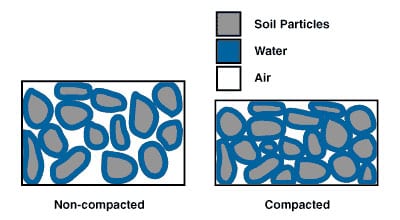Compact soils can lead to a variety of problems in the landscape. While it is difficult to visually see how compact soil reduces air spaces and impacts nutrient cycling, issues of poor drainage and failure to establish are obvious. Urban soils support buildings, roads, and sidewalks, but all too often the buildings’ benefit is a pain for the plants.
When you think of soil, you probably think of the stuff that makes your hands dirty. That is only half of the story! Soil is a diverse complex of sand, silt, clay, organic material, and air. The soil provides support for the plants to anchor their roots, nutrient exchange for healthy growth, and water availability as the plants need it. There is a lot of physics and chemistry involved in these processes. To keep it simple, those air pockets are where the roots burrow deeper, scavenging for water and nutrients, adding strength and stability to the entire plant.
Compacted soils are common in urban ecosystems since homes, roads, and sidewalks require firm ground for construction. Desirable landscape plants can have a hard time establishing in compact soils reminiscent of concrete. Issues include lack of rooting in, never growing beyond the root ball, root girdling, and shallow rooting. These issues lead to poor plant performance and toppling over in addition to environmental issues associated with changing the hydrology of an area. Native Florida soils are well drained and allow for rainwater to infiltrate through the soil column, while compacted Florida soils cause water to flow across the surface in unnatural patterns.
Compaction on a large scale is usually associated with construction, but on a small scale, areas of high foot traffic or golf cart paths are more firm than surrounding areas. Look for an area with small scale compaction to observe the subtle differences in plant performance, weed species present, and standing water. Now, imagine an entire site or neighborhood on compact soils!
You will deal with compact soils. Here is how:
Prevent soil compaction by reducing traffic in areas to be planted. Communicate during construction. Have designated parking areas, avoid working the soil when wet, and spread thick mulch over an area likely to get stomped. If you are brought in to install plants post construction, you need to have a plan to deal with compacted soils.
Deep tillage or subsoiling can be done to break up the top 2-3 feet of soil mechanically and is best done post construction, and pre plant installation. Be careful of utilities.
Shallow tillage can break up surface compaction in the top 6 inches of soil without impacting most buried utilities, but this will not solve issues deeper in the soil. A rototiller can also blend in a compost amendment to improve soil structure and water holding capacity.
Plug aeration is practiced on athletic fields and golf courses to help manage compaction with minimal harm to the turfgrass roots.
Air tilling can be used to loosen soil around existing tree and shrub roots with minimal damage to existing roots.
Compost amendments added to the soil can help to reduce compaction while improving water and nutrient holding capacity. The tiny particles of organic matter can wiggle into the tiniest spaces between soil particles, thus alleviating compaction issues over time!
Soil replacement is intensive and expensive, but in the right high end landscape, an engineered soil can help accomplish the goals of the construction plans and the landscape plans. Structural soils have been developed that can meet construction standards and plant needs for long term vitality.
Containers are a nice work around in small spaces suffering from compaction issues.
Learn more in this UF/IFAS EDIS “Soil Compaction in the Urban Landscape”
 0
0
